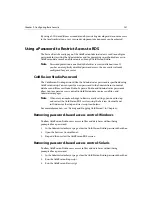
Chapter 10: Configuring Advanced Security
301
Defining User Directories
User and group authentication is carried out against either an existing Windows NT
domain, an LDAP directory, or an ODBC data source. When you set up Advanced
security, you must specify at least one user directory. You can add as many user
directories as you like. Once you define a user directory, it is available for you to use
with any security context you define for this security server.
•
Windows NT Domains
— Authenticating against a Windows NT domain makes
sense if you are already working in a Windows NT environment or will be
deploying your application code to a Windows NT environment. This method is
a very quick way to implement ColdFusion Advanced security, since users and
groups have already been defined. ColdFusion Advanced security doesn’t
provide any user/group management facilities; you must manage users and
groups using the Windows NT User Manager for Domains administrative utility.
•
LDAP Directories
— If you are running ColdFusion Server on a UNIX server, you
can only use LDAP directories to store your security profile information.
ColdFusion includes a restricted-use license of the Netscape Directory Server.
This embedded Netscape Directory Server is restricted for use in conjunction
with security access control, policy storage, and user authentication and
cannot be used for any other purpose. Only Netscape-supplied Directory Server
administration tools, command line programs and user interfaces, provided
with the embedded version can be used to modify or access the database in a
manner consistent with its restricted license. There is no user count restriction
on your use of Directory Server. On UNIX, you can find the Netscape Directory
Server tar file(s) in the
ldap
directory on the ColdFusion CD.
To use the Netscape Direcotry Server on UNIX, you must install it before
installing ColdFusion Server. If you have already installed ColdFusion Server
and you want to use the Netscape Directory Server to store security profile
information, you must reinstall ColdFusion after installing Netscape Directory
Server.
•
ODBC Data Sources
— If your ColdFusion applications are already using a
Sybase, Oracle, or any other database that supports connections through
ODBC, you can use your existing database to also store your security profile
tables. You must register an ODBC data source with ColdFusion before you can
use it to store security profile information. See Chapter 4, “Managing Data
Sources” for more information about registering data sources with ColdFusion.
See “Specifying Resources to Protect” on page 305 to learn how to use an ODBC
data source for username and password security authentication.
Summary of Contents for COLDFUSION 4.5-ADMINISTRING COLDFUSION...
Page 1: ...Allaire Corporation Administering ColdFusion Server ColdFusion 4 5...
Page 10: ...x Administering ColdFusion Server...
Page 22: ...xxii AdministeringColdFusionServer...
Page 48: ...26 Administering ColdFusion Server...
Page 58: ...36 Administering ColdFusion Server...
Page 60: ...38 Administering ColdFusion Server Using ColdFusion in a Distributed Configuration 68...
Page 98: ...76 Administering ColdFusion Server...
Page 150: ...128 Administering ColdFusion Server...
Page 198: ...176 Administering ColdFusion Server...
Page 205: ...Chapter 6 Creating Scalable and Highly Available Web Sites 183 3 Click the DNS tab...
















































